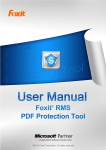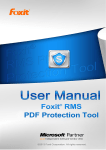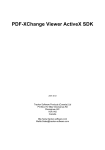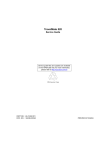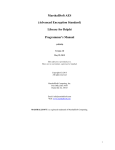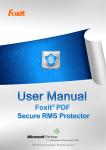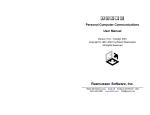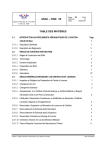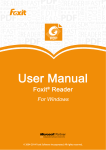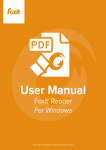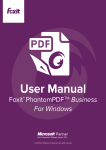Download User Manual - Foxit Software
Transcript
Foxit RMS PDF Protection Tool User Manual 1 Foxit RMS PDF Protection Tool User Manual Copyright © 2015 Foxit Software Incorporated. All Rights Reserved. No part of this document can be reproduced, transferred, distributed or stored in any format without the prior written permission of Foxit. Anti-Grain Geometry - Version 2.3, Copyright (C) 2002-2005 Maxim Shemanarev (http://www.antigrain.com). FreeType2 (freetype2.4.9), Copyright (C) 1996-2001, 2002, 2003, 2004| David Turner , Robert Wilhelm, and Werner Lemberg. LibJPEG (jpeg V6b 27-Mar-1998), Copyright (C) 1991-1998 Independent JPEG Group. ZLib (zlib 1.2.5), Copyright (C) 1995-2003 Jean-loupGailly and Mark Adler. Little CMS, Copyright (C) 1998-2004 Marti Maria. Kakadu - Version 4.5.1, Copyright (C) 2001, David Taubman, The University of New South Wales (UNSW). PNG, Copyright (C) 1998-2009 Glenn Randers-Pehrson. LibTIFF, Copyright (C) 1988-1997 Sam Leffler and Copyright (C) 1991-1997 Silicon Graphics, Inc. Jbig2enc 0.27, Copyright (C) 2006 Google Inc. Lleptonlib 1.63, Copyright (C) 2001 Leptonica. Lcms 2.0, Copyright (c) 1998-2010 Marti Maria Saguer. WCELIBCEX 1.0, Copyright (c) 2006 Mateusz Loskot. libjpeg-turbo 1, Copyright (C)2011 D. R. Commander. Microsoft AD RMS SDK 2.0, Copyright (C) 2012 Microsoft Corporation. Permission to copy, use, modify, sell and distribute this software is granted provided this copyright notice appears in all copies. This software is provided "as is" without express or im-plied warranty, and with no claim as to its suitability for any purpose. 2 Foxit RMS PDF Protection Tool User Manual Content Pre-installation Information ..................................................................... 4 System requirements ............................................................................... 4 RMS Command Line Tool Commands ....................................................... 4 RMS Command Line Tool Registration ...................................................... 7 Using the RMS Protection Tool in Conjunction with the Windows Server File Classification Infrastructure ............................................................... 7 Dynamic Security Watermarks ............................................................... 18 Quick Start Guide for Using Windows Azure AD Rights Management .... 25 Contact Us .............................................................................................. 27 3 Foxit RMS PDF Protection Tool User Manual User Manual Foxit RMS PDF Protection Tool provides a command-line interface that can decrypt multiple AD RMS protected PDF files or encrypt multiple PDF files by a predefined official rights-policy template. This tool can be used to safeguard existing sensitive data on company shares. It also works in conjunction with the File Classification Infrastructure (FCI) feature in Windows Server 2008/2012 to classify and protect sensitive company data. Pre-installation Information To run this tool, you must have the latest version of the AD RMS client installed. If you have an existing older version of the AD RMS client installed, you will need to uninstall the old version first and then download and install the latest version of the AD RMS client from below: For X86: http://us-request.foxitservice.com/products/redirect.php?title=ad_rms_sdk_x86&language=en_ us For X64: http://us-request.foxitservice.com/products/redirect.php?title=ad_rms_sdk_x64&language=en_ us As for using Windows Azure AD Right Management (AAD RMS), please refer to the Quick Start Guide for Using Windows Azure AD Rights Management. System requirements Supported operating systems: Windows Vista, Windows 7, Windows 8, Windows Server 2008 and 2008 R2, Windows Server 2012 RMS Command Line Tool Commands The following syntax, parameter description, and example sections describe the Foxit RMS Command Line Tool commands. Format Meaning Monospace Elements that the user must type exactly as shown. 4 Foxit RMS PDF Protection Tool User Manual Between angle brackets < > Placeholders for values that the user must supply. Between square brackets [ ] Optional items. Syntax RMSProtector [/decrypt <location>] [/encrypt <location> </template <name> [issuer]> [/highstrength] [/revoke] [/MicrosoftIRMV1]] [/encrypt <location> </user <name> /rights <rights> [issuer]> [/highstrength] [/revoke] [/MicrosoftIRMV1]] [/showtemplates [/sync]] [/preserveattributes] [/showencryption <location>] [/log <log_file> [/append] [/simple]] [/silent] [/license] [/register <code> <licensee>] Parameters Parameter Description /decrypt <location> Performs a batch decryption. This will decrypt all of the PDF files that reside in the location that is specified with this parameter. Performs a batch encryption. This will encrypt all of the PDF files that reside in the location based on the rights policy template that is /encrypt <location> specified along with this parameter. </template <name> The <issuer> argument lets you specify an issuer of rights policy [issuer] > [/highstrength] template. The /highstrength is an updated and enhanced AD RMS cryptographic implementation. /revoke This parameter is used to revoke a document that has been issued, or revoke a user that has been authorized with access rights. If you want to use this command, you need to configure the web service first. For detailed configuration steps, please refer to Web Service Configuration. /showencryption location This parameter will show user permission information for the encrypted files at ‘location’. /showtemplates [/sync] /preserveattributes The /showtemplates parameter can show the available templates. The /sync parameter will download the rights policy templates from the server synchronously. This parameter preserves all the original file attributes. These attributes includes the following: Owner, Creation Time, Modified Time, and Accessed Time. For example, when this parameter is used with the File Classification Infrastructure in Windows Server 2008 R2, there can be a rule in place to delete all files that were not modified 5 Foxit RMS PDF Protection Tool User Manual or accessed in the last 10 years. This option preserves all these original attributes. Performs an output to a log file. The log file contains a header that will show the status during the prerequisite stage and a footer that will shows the summary of the run. The log file will also show the file count information. The /simple flag allows the header, footer, and file numbering /log <log_file> [/append] information to be left out of the log file. This is useful when the tool is [/simple] used together with File Classification Infrastructure, because it will let you append the log file without the header, footer, and file numbering information. The /append flag will add the new information to a pre-existing log file. By default, if the /simple or /append flag is not specified when you are using a pre-existing log file, the log file will be overwritten. /silent This parameter disables console logging. /MicrosoftIRMV1 This parameter is used to encrypt PDFs with Microsoft IRM Protection Version 1, which is a Microsoft extension to the PDF format to support Microsoft IRM protection. The extension allows PDFs to be encrypted by Microsoft IRM technology that is implemented by Microsoft’s Active Directory Rights Management Server as well as by Azure Rights Management. If not defined, Microsoft IRM Protection Version 2 (PPDF) will be used. /license This parameter is used to check whether the command line tool is licensed or not. /register This parameter is used to register the command line tool with an activation code. Examples The following shows an example of decrypting files on a network share: RMSProtector.exe /decrypt \\Share\Folder /log RMSProtector.log The following shows an example of encrypting local files: RMSProtector.exe /encrypt C:\Documents\Folder /template TemplateName /log C:\Logs\RMSProtector.log The following shows an example of encrypting an individual file on a network share. RMSProtector.exe /encrypt \\Share\file.pdf /template TemplateName IssuerName /log C:\Logs\RMSProtector.log /append /simple/preserveattributes The following shows an example of directly encrypting files: RMSProtector.exe /encrypt C:\Documents\Folder /user [email protected],[email protected] /rights VIEW,ANNOTATE /revoke User Rights include the following: 6 Foxit RMS PDF Protection Tool User Manual ALL: Full control VIEW: View document PRINTLOW: Print with low resolution PRINTHIGH: Print with high resolution FILLFORM: Fill in a form ANNOTATE: Comment in the document ASSEMBLE: Manage pages and bookmarks MODIFY: Modify document EXTRACTACCESS: Content copying for accessibility EXTRACT: Extract the contents of the document RUNJAVASCRIPT: Run JavaScript RMS Command Line Tool Registration When you receive an activation code for the command line tool, please use the argument “/register <code> <licensee>” to activate it in the command line window. For example, assume you have the activation code (40G01-02000-M2000-HS6AW-QCX62-FOXITT), you can use the command “rmsprotector.exe /register 40G01-02000-M2000-HS6AW-QCX62-FOXITT test”. Here, “test” is the name of the licensee you designated. After activation, a key file named “ftlkey.txt” will be generated in the installed path. Then you can run “rmsprotector.exe /license” in the command line window to check the license information. Using the RMS Protection Tool in Conjunction with the Windows Server File Classification Infrastructure The following steps will guide you through setting up the RMS Command Line Tool and FCI. 1. Unzip installation package to the specified directory. a. Log on to the FCI Server as Administrator. b. Unzip command line tool to: C:\Windows\SysWOW64 c. If you have purchased the product, please place the key file in this directory. 2. Grant FCI Machine Account Read and Execute Permissions. a. Log on to the AD RMS Server as an Administrator. b. Navigate to C:\Inetpub\wwwroot\_wmcs\Certification, ServerCertification.asmx and select Properties. right-click on 7 Foxit RMS PDF Protection Tool User Manual c. d. e. f. g. h. i. On the ServerCertification.asmx properties, select the Security tab, and then click Edit. On the Permissions for ServerCertification.asmx screen, click Add. On the Select Users, Computers, or Groups screen, to the right, click the Object Types… button. On the Object Types screen, place a check in Computers and click Ok. On the Select Users, Computers, or Groups screen, under Enter the object names to select, type <domain>\<machinename> and then click Check Names. This should validate the machine with an underline. Click Ok. On the Permissions for ServerCertification.asmx screen, select the newly added machinename and verify it has a check in Read & execute. Click Apply and then OK. On the ServerCertification.asmx properties, click Ok. 3. Grant AD RMS Service Group Read and Execute Permissions a. On the Select Users, Computers, or Groups screen, under Enter the object names to select, enter ADRMS\AD RMS Service Group and click Check Names. This should resolve with an underline. Click Ok. b. On the Permissions for ServerCertification.asmx screen, select the newly added AD RMS Service Group and verify it has a check in Read & execute. Click Apply and then Click Ok. c. On the ServerCertification.asmx properties, click Ok. d. Restart the AD RMS server. 4. Create a shared folder a. Log on to FCI Server as Administrator b. Click Start, click Computer, and then double-click Local Disk (C:). c. Click File, point to New, and then select Folder. d. Type SharedFolder for the new folder's name, and then press ENTER. e. Right-click SharedFolder, click Share with, and then click Specific people. f. On the File Sharing window, in the box under Type a name and then click Add, or click the arrow to find someone select Everyone, then and click Add. 8 Foxit RMS PDF Protection Tool User Manual The Everyone group should now appear in the box below. Under Permission Level, select Read/Write. g. h. Click Share. The window should change and you should now see Your folder is shared. Click Done. 5. Restrict files a. Log on to FCI server as Administrator b. Copy the script from Appendix 1 into Notepad and save it as c:\windows\system32\FoxitProtect.ps1. c. Click Start, click Administrative Tools, and click File Server Resource Manager. d. In the File Server Resource Manager, on the left, right-click File Management Tasks, and select Create File Management Task. This will bring up the Create File Management Task window. e. Under Task name: enter Restrict files. f. Under Description, enter Apply Confidential rights policy. g. Under Scope, click Add and then browse to SharedFolder. h. At the top, click the Action tab. i. Under Type, select Custom from the drop-down. j. Under Executable, select Browse and navigate to c:\windows\system32\WindowsPowerShell\v1.0\powershell.exe. k. Under Arguments, enter -File c:\windows\system32\FoxitProtect.ps1 [Source File Path]. 9 Foxit RMS PDF Protection Tool User Manual l. m. n. o. Under Run the command as:, select Local System. At the top, click the Condition tab. Click Add. This will bring up the Property Condition window. On the Property Condition window, make sure Property: is set to Business Impact, set the Operator: to Equals, and for the Value: select Low from the drop-down. Click OK. Note: If you could not find Business Impact under Property, please follow the steps below to create Business Impact Classification Property first. a) b) c) d) e) f) Log on to FCI server as Administrator. Click Start, click Administrative Tools, and click File Server Resource Manager. In the File Server Resource Manager, on the left, expand Classification Management, and right-click Classification Properties, and select Create Property. This will bring up the Create Classification Property Definition window. Under Property name, enter Business Impact. Under Description, enter Describes the impact to the business if this file were to be disclosed to the public. Valid values are High and Low. Under Property type, enter Ordered List. 10 Foxit RMS PDF Protection Tool User Manual g) h) i) p. q. Down under Value enter High. This will add a row below the value we just entered. Under the High value we just added, enter Low. Click OK. Click Add. This will bring up the Property Condition window. On the Property Condition window, make sure Property: is set to dateEncrypted, and select not exist for the condition. Click OK. Note: If you could not find dateEncrypted under Property, please follow the steps below to create dateEncrypted Classification Property first. a) b) c) d) e) f) g) r. s. t. u. v. w. Log on to FCI server as Administrator. Click Start, click Administrative Tools, and click File Server Resource Manager. In the File Server Resource Manager, on the left, expand Classification Management, and right-click Classification Properties, and select Create Property. This will bring up the Create Classification Property Definition window. Under Property name, enter dateEncrypted. Under Description, enter When this document was encrypted. Under Property type, enter Date-Time. Click OK. At the top, click the Notification tab. Click Add. This will bring up the Add Notification window. Set the Number of days before the task is executed to send notification to 0, and configure E-mail Message or Event log, then press OK. At the top, click the Schedule tab. On the Schedule tab, click Create. This will bring up the Schedule window. Configure the time you want to schedule the script to run and then press OK. Note: 1. After the installation of PowerShell, the execution of scripts is disabled by default. You must enable your system to run the scripts. This can be done by using the following command: Set-Executionpolicy Unrestricted. 2. The CLI running in FCI is in server mode. So the policy template is stored in another folder different from the client mode, usually in C:\Users\All Users\Microsoft\MSIPC\Server\Templates. When running the CLI in FCI, you can use the following FCI script to sync templates and encrypt files. $encryptfile = '"' + $args[0] + '"' $r = start-process -Wait -PassThru -FilePath C:\Windows\SysWOW64\RMSProtector.exe -ArgumentList "/showtemplates", "/sync" $r = start-process -Wait -PassThru -FilePath C:\Windows\SysWOW64\RMSProtector.exe 11 Foxit RMS PDF Protection Tool User Manual -ArgumentList "/encrypt", $encryptfile, "/template", "C:\SharedFolder\RmsLog.log", "/append" '"RMS SVR TemplateA"', "/log", Appendix 1 The following Windows Powershell script is used to create the file management task to restrict files # execute bulk tool $encryptfile = '"' + $args[0] + '"' $r = start-process -Wait -PassThru -FilePath C:\Windows\SysWOW64\RMSProtector.exe -ArgumentList "/encrypt", $encryptfile, "/template", "[TemplateName]", "/log", "C:\SharedFolder\RmsLog.log", "/append", "/preserveattributes" if ($r.ExitCode -eq 0) { $c = new-object -com Fsrm.FsrmClassificationManager $d = (get-date).toFileTimeUTC() $d = $d - ($d % 10000000) $c.SetFileProperty($args[0], "dateEncrypted", $d.ToString()) } Note: 1. [TemplateName] in the script should be filled out with real information. If [TemplateName] includes spaces, for example, the template name is “security audit mechanism”, the script should be written as "/template", '"security audit mechanism"'. 2. To encrypt a document using custom templates, please create a custom template first (for how to create a custom template, please refer to Create Template), and then copy “Foxit Software” folder under C:\Users\User name (the current user of the operation system)\AppData\Roaming to C:\Users\Default\AppData\Roaming. Custom Templates Foxit RMS PDF Protection Tool allows users to encrypt documents by custom templates. You can create custom templates by Configuration Tool, call “showtemplates” command to display the custom templates and then encrypt documents by the created template via “encrypt” command. Also, you can manage the custom templates with the Protection Tool. Please refer to the instructions below for details. Create Template To create a custom template, please see the following steps: 1. Run the file “Foxit Configuration Tool.exe” in the unzipped folder and choose the Custom 12 Foxit RMS PDF Protection Tool User Manual Template tab. 2. Click Create. 3. Click Add in the Create Custom Rights Policy Template dialog box. 4. Choose the language and edit template name and description. Click OK. The template name and description will be shown in the Template Identification list. You can add a name and description in different languages for the template you want to create via clicking Add. 5. Click Next to turn to Add User Rights. 13 Foxit RMS PDF Protection Tool User Manual 6. Click Add button to add users you would like to assign rights to. Input e-mail addresses in the field under “The e-mail addresses of users or groups” option or click the Browse button to select email addresses from Outlook. Select Anyone to assign rights to all users. Click OK to finish adding. 7. Check PDF permissions for the above users. You can set the permissions for all of the users or set different permissions for different users. 8. “User can request additional permissions from:” this option will allow users to request additional permissions by sending email to the address(es) you list here. 9. Click Next to set the expiration policy. 14 Foxit RMS PDF Protection Tool User Manual Content expiration Never expires: the PDF content can be viewed indefinitely. Expires on the following date: the PDF content will expire on a given date. Expires after the following duration (days): the PDF content will expire after the desired days selected. Use license expiration Requires user to re-verify permissions with the server after the following duration (days): users need to apply for a new license to open the encrypted PDFs several days (the number you type into) later. 10. Click Next to specify extended policy. 15 Foxit RMS PDF Protection Tool User Manual Security Watermark To add a security watermark, please check Security Watermark first, and then follow the steps specified in Add a required watermark. Only allow access by this IP range: Check the option and specify an IP range that is allowed to access a document. Other IP ranges will not be able to access the document. Only allow access to these pages: Check the option and specify the page number(s) that a user is allowed to access. Other pages will not be viewable. Number of accesses: Check the option and specify the number of times that a user is allowed to access a document. Number of prints: Check the option and specify the number of times that a user is allowed to print a document. 11. Click Finish to complete creating the template. Note: If you want to control “Number of accesses” or “Number of prints” in an on-premise environment, you need to configure the web service first. For detailed configuration steps, please refer to the attached Web Service Configuration. Manage Custom Template 16 Foxit RMS PDF Protection Tool User Manual You can edit and delete the custom templates you created with the Foxit Configuration Tool. To edit a template, please follow the steps below: 1. Run the file “Foxit Configuration Tool.exe” in the unzipped folder and choose the Custom Template tab. 2. Choose the template you want to edit and click Edit to open Edit Custom Rights Policy Template. 3. Edit the template as required. For the instructions on how to edit the template, please refer to Create Template for details. To delete a template, select the template you want to delete, and click Delete and Yes. 17 Foxit RMS PDF Protection Tool User Manual Dynamic Security Watermarks Create and manage dynamic watermarks Dynamic security watermarks automatically display viewer identity information on protected PDF files to protect against compromise from screen shots and cameras. Create dynamic watermarks 1. Unzip the installation package on RMS server. 2. Run the file “Foxit Configuration Tool.exe” in the unzipped folder and choose Security Watermark tab to open Security Watermark Management. 3. Add a required watermark. 18 Foxit RMS PDF Protection Tool User Manual i.Click New Profile to create a profile and name it. ii.Select a profile you created and click Add to add watermarks in the profile. iii.Type the watermark’s name. iv.Type the watermark’s content in the text box and set the font, size, color, underline, and alignment. Note: you can only set text as watermark. v.Choose the Dynamic Text. When any PDF reader opens the file, the watermark will show the current document information dynamically. Note: you can apply multiple watermarks to a single document. Content ID: shows the content ID of the current document. Document Title: shows the current document title. Author: shows the author of the current document. Current User: shows the current user who is reading the document. Date: shows the current system date when opening the document. Day: shows the current system day when opening the document. Month: shows the current system month when opening the document. Year: shows the current system year when opening the document. Time: shows the current system time when opening the document. Hour: shows the current system hours when opening the document. Minute: shows the current system minutes when opening the document. Second: shows the current system seconds when opening the document. vi.Set the appearance by choosing the rotation degree and the opacity. You also have the option to scale relative to the target page. vii.Set the vertical and horizontal distance between the target page edge or center and the watermark. 19 Foxit RMS PDF Protection Tool User Manual viii.Choose the page range to display the watermark. You can select the different page range options via clicking the items in the subset list. ix.Preview the watermark in the right pane. x.Click OK to exit. Manage dynamic watermarks Edit a Watermark i.Open the Security Watermark Management and select a watermark you want to edit. ii.Click Edit to open the Create Security Watermark dialog box. iii.Begin editing the watermark, please refer to “Add a required watermark”. iv.Click OK to finish the operation. Delete a Watermark i.Open the Security Watermark Management and select a watermark you want to delete. ii.Click Delete to remove the selected watermark. Add dynamic security watermarks to a custom template To add dynamic security watermarks to a custom template, select the dynamic security watermarks as needed while creating the custom template. Add dynamic security watermarks to an official template To add dynamic security watermarks to an official template, you need to use Foxit Configuration 20 Foxit RMS PDF Protection Tool User Manual Tool (for RMS server). Steps are as follows: 1. 2. Log on to the RMS server. Download the Foxit Configuration Tool from: For X86: http://cdn01.foxitsoftware.com/pub/foxit/rms/configtool/FoxitConfigurationTool_32.zip For X64: http://cdn01.foxitsoftware.com/pub/foxit/rms/configtool/FoxitConfigurationTool_64.zip 3. Unzip and run the Foxit Configuration Tool. 4. Click Template Extended Policy. Select a template to edit. 21 Foxit RMS PDF Protection Tool User Manual 5. Click Select, and then follow the steps specified in Add a required watermark to add watermarks to official templates. Dynamic Revocation Revocation is a mechanism that revokes a PDF document that has been issued, or revoke a user that has been authorized with access rights. For example, you can remove access to a document when it becomes out of date, or remove rights for an individual when he is no longer authorized. To revoke a PDF document or user in an on-premises environment, please refer to the attached Web Service Configuration to configure the web service first. Revoke a PDF Document 1. Log on to the RMS server. 2. Download the Foxit Configuration Tool from: For X86: http://cdn01.foxitsoftware.com/pub/foxit/rms/configtool/FoxitConfigurationTool_32.zip For X64: http://cdn01.foxitsoftware.com/pub/foxit/rms/configtool/FoxitConfigurationTool_64.zip 3. Unzip and run the Foxit Configuration Tool. 22 Foxit RMS PDF Protection Tool User Manual 4. Click Document Revocation. 5. Select the PDF document you want to revoke, click Add button to add the document to the Revocation List. Or you can click Browse to select a document from a local drive to add to the 23 Foxit RMS PDF Protection Tool User Manual Revocation List. Revoke a User 1. Log on to the RMS server. 2. Run the Foxit Configuration Tool. 3. Click User Revocation. 24 Foxit RMS PDF Protection Tool User Manual 4. Click Add button to add a user to the User Revocaton List. Quick Start Guide for Using Windows Azure AD Rights Management Enable Windows Azure AD Rights Management for your organization: Download the Windows Azure AD Rights Management administration module (WindowsAzureADRightsManagementAdministration.exe) for Windows PowerShell from here. In the local folder where you downloaded and saved the Rights Management installer file, double-click the file WindowsAzureADRightsManagementAdministration.exe to launch installation of the Rights Management administration module. Open Windows PowerShell. Type the following commands: Import-Module AADRM Connect-AadrmService -Verbose 25 Foxit RMS PDF Protection Tool User Manual Enter your Office 365 credentials when prompted, for example“[email protected]”. Type the following commands: Enable-Aadrm Disconnect-AadrmService 26 Foxit RMS PDF Protection Tool User Manual Contact Us Feel free to contact Foxit should you need any information or have any problems with our products. We are always here, ready to serve you better. Office Address: Foxit Software Incorporated 42840 Christy Street. Suite 201 Fremont CA 94538 USA Sales: 1-866-680-3668 (24/7) Support: 1-866-MYFOXIT or 1-866-693-6948 (24/7) Fax: 1-510-405-9288 Website: www.foxitsoftware.com E-mail: Sales and Information - [email protected] Technical Support - Input a trouble ticket online Marketing Service - [email protected] 27




























